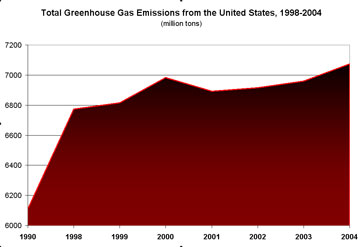Supreme Court to decide on global warming issue
Supreme Court to decide on global warming issue
mongabay.com
November 29, 2006
America’s highest court will decide whether the U.S. government should regulate carbon dioxide (CO2) emissions.
The case, known as Massachusetts v. EPA pits the Environmental Protection Agency (EPA), an agency charged with protecting the environment, with the auto and power industries and 10 states against a dozen mostly northeastern and western states and 13 environmental organizations. The EPA opposes regulation of carbon dioxide, a potent greenhouse gas scientists say contributes to global warming, arguing that CO2 is a naturally occurring gas that does not fit the U.S. Clean Air Act’s definition of a pollutant.
The Supreme Court is expected to rule on this case by the middle of next year.
The plaintiffs, which include the states of California, Connecticut, Illinois, Massachusetts, Maine, New Jersey, New Mexico, New York, Oregon, Vermont and Washington, say that carbon dioxide should be controlled under the Clear Air Act which requires the EPA to regulate any “chemical… substance or matter which is emitted into or otherwise enters the ambient air” that the agency determines to “cause, or contribute to, air pollution which may reasonably be anticipated to endanger public health or welfare.” Environmental groups note that the act specifically defines “welfare” to include adverse impact on “weather” and “climate.”
 
|
“When it comes to global warming, the [Bush] administration acts like a 97-pound weakling claiming to have no authority to regulate the heat-trapping pollution spewed out by vehicles and power plants,” read a statement from the Natural Resources Defense Council, an environmental advocacy group involved in the suit. “The good news is that regardless of the outcome of this case, the global warming deniers are losing the battle. American states and cities have put global warming solutions at the top of their agendas. Clean, renewable energy is now the darling of Silicon Valley venture capitalists. And hybrid cars can’t be kept on the lots, while gas guzzlers are collecting dust in the showrooms. The rest of the industrialized world is already acting.”
The U.S. transportation sector produced about 6 percent of global carbon emissions and around a third of total U.S. energy-related carbon-dioxide emissions in 2005, according to the Department of Energy’s Energy Information Administration (EIA). EIA figures show that in 2005 total U.S. greenhouse gas emissions rose to 7,147 million metric tons, a new record. About 83 percent of total U.S. greenhouse gas emissions in 2005 consisted of carbon dioxide from the use of fossil fuels including coal, petroleum, and natural gas.
The U.S. is the largest producer of carbon dioxide. China, the number two emitter, is expected to surpass the United States sometime in 2009, though its emissions per capita will still less than a quarter of that of the U.S.
Atmospheric CO2 levels have climbed by more than 35 percent since the beginning of the industrial revolution. Fossil fuel combustion, which releases carbon dioxide into the atmosphere, and land-use change, including deforestation, is blamed for the rise. Roughly 75-80 percent of anthropogenic carbon dioxide results from fossil fuel burning, while about 20-25 percent is produced by deforestation. The United States, the world’s largest economy and consumer of energy, produces about 24% of global carbon dioxide emissions.
Scientists believe rising levels of carbon dioxide and other greenhouse gases are causing Earth’s atmosphere to warm. Research released earlier this year by NASA, WMO, and the National Academy of Sciences found that 2005 was the warmest year in at least the 400 years, and possibly much longer. The WMO says that carbon dioxide has accounted for 90 percent of warming over the past decade.
The Intergovernmental Panel on Climate Change (IPCC) projects that atmospheric carbon dioxide levels could rise to 450-550 ppm by 2050, possibly resulting in higher temperatures, rising sea levels, stronger storms and hurricanes, and expanding deserts.
Related

|
United States economy becomes more carbon efficient . The state of Nevada had the largest increase in carbon emissions between 1990 and 2001 according to mongabay.com’s analysis of figures released by the Energy Information Administration. Carbon dioxide emissions climbed 47 percent during the period, while the state’s economy grew by 85 percent and its population increased by 73 percent. The figures show that Nevada, like the rest of the United States, is becoming getting more out of its carbon dioxide emissions than it did in 1990.
Energy efficiency helped California grow an extra $31 billion finds study.
Environmental officials for the state of California and the Brazilian state of Sao Paulo have found significant evidence that greenhouse gas pollution can be substantially reduced at a profit rather than a cost. The study, commissioned by the William and Flora Hewlett Foundation, found that energy efficiency has helped the California economy grow an extra 3 percent – a $31 billion gain – compared to business as usual. Further, the researchers say that each Californian typically saved about $1,000 per year between 1975 and 1995 just through efficiency standards for buildings and appliances.
US Greenhouse gas emissions hit record in 2004. Figures released Monday show that US greenhouse gas emissions hit a record in 2004, rising 1.7 percent over 2003. The increase, equivalent to a rise of 115 million tons of carbon dioxide, was the largest annual increase since 2000.